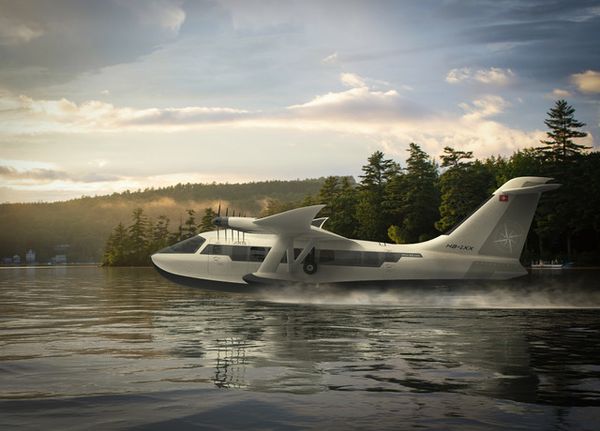Alaska Airlines, headquartered in Seattle, Washington, has transferred a Bombardier Q400 regional turboprop aircraft to ZeroAvia to equip it with a hydrogen-electric propulsion system.

This action aims to expand the reach and viability of zero-emission aviation technology.
Alaska Airlines Partnership with ZeroAvia
At ZeroAvia's Paine Field research and development site, Alaska Airlines delivered a Bombardier Q400 regional turboprop aircraft to ZeroAvia. The hydrogen-electric propulsion system will be integrated into the aircraft after the handover.
This event was attended by Raisbeck Aviation High School students, Washington State Governor Jay Inslee, Congresswoman Suzan DelBene, and Snohomish County Executive Dave Somers. The handover of the 76-seat Q400 aircraft marked its official transfer to ZeroAvia.
Horizon Air, a regional carrier of Alaska Airlines, has designated one of its Q400 aircraft for research and development purposes to continue exploring zero-emission technology for the aviation industry.

After retiring its Q400 fleet, the U.S.-based company has partnered with ZeroAvia, a leader in designing and developing hydrogen-electric aircraft propulsion systems for zero-emission flight technology, to retrofit the aircraft with a hydrogen-electric propulsion system.
The plane has been given a special livery to showcase the innovative mission of the partnership.
ZeroAvia Unveils 1.8MW Modular Electric Motor System
ZeroAvia showcased a 1.8MW prototype of its multi-megawatt modular electric motor system at the event, which was demonstrated by a propeller spin on a 15-ton HyperTruck ground-test rig.
The electric motor technology is a crucial element in developing commercially feasible hydrogen fuel cell engines for larger aircraft and is complemented by in-house developed higher-temperature PEM fuel cells and advanced power electronics.

ZeroAvia's recent advancements set the stage for potential flight tests of the Q400 (also known as the Dash 8-400) and showcase a quick development path toward certifying the ZA2000 propulsion system.
With a track record of leading world-first flight tests, ZeroAvia flew a refurbished 19-seat aircraft in January with a prototype 600kW hydrogen-electric engine (ZA600).
This followed its demonstration flight of a 250kW system in 2020, which was the largest-ever aircraft flown with an innovative zero-emission power source at the time.
CEO Statements
Ben Minicucci, the CEO of Alaska Airlines, has expressed that the partnership between Alaska Airlines and ZeroAvia in developing the world's largest zero-emission aircraft is a remarkable achievement in aviation innovation that will contribute to a more sustainable and eco-friendly future for the industry.

The collaboration is expected to help the airline achieve its goal of achieving net zero carbon emissions, and Minicucci acknowledged that new technologies would be vital in achieving that objective.
He expressed his excitement about partnering with industry leader ZeroAvia to make zero-emission alternatives a reality.

ZeroAvia CEO and founder, Val Miftakhov, expressed his excitement about the program's potential impact and said, "Demonstrating an aircraft of this size in flight, powered entirely by advanced propulsion technology, was unimaginable just a few years ago."
"By launching this program, we are on target to conduct a test flight next year, which will significantly accelerate our progress towards achieving a future of zero-emission aviation for Alaska Airlines and the world," added ZeroAvia CEO.
Wizz Air Relaunches Suceava Base with Two A321neos and Seven New Routes » American Airlines Unveils 15 New Routes for 2026 Expansion » Citation C550 Fireball: Greg Biffle and Five Others Killed in Failed Emergency Landing at KSVH »
Comments (0)
Add Your Comment
SHARE
TAGS
NEWS Alaska Airlines ZeroAvia Alaska ZeroAvia Partnership Zero Emissions Electric Aircraft Hydrogen-Powered AircraftRECENTLY PUBLISHED
 The Runway is Obsolete: Jekta Swiss is Resurrecting the Flying Boat for the 21st Century
AeroXplorer sat down with George Alafinov, CEO & Co-founder of Jekta Swiss. In conversation, he discussed the company's unique value proposition and how he sees his aircraft revolutionizing the amphibious aircraft industry.
STORIES
READ MORE »
The Runway is Obsolete: Jekta Swiss is Resurrecting the Flying Boat for the 21st Century
AeroXplorer sat down with George Alafinov, CEO & Co-founder of Jekta Swiss. In conversation, he discussed the company's unique value proposition and how he sees his aircraft revolutionizing the amphibious aircraft industry.
STORIES
READ MORE »
 Why Fast Price Estimation Has Become Critical for Brokers and Clients
In today's private aviation market, speed is no longer a "nice to have." It's an expectation. Brokers, operators, and clients all work under tighter timelines, higher price sensitivity, and far less tolerance for vague answers. When someone asks, "How much will this flight cost?" they don’t want a rough guess tomorrow; they want a credible answer now.
INFORMATIONAL
READ MORE »
Why Fast Price Estimation Has Become Critical for Brokers and Clients
In today's private aviation market, speed is no longer a "nice to have." It's an expectation. Brokers, operators, and clients all work under tighter timelines, higher price sensitivity, and far less tolerance for vague answers. When someone asks, "How much will this flight cost?" they don’t want a rough guess tomorrow; they want a credible answer now.
INFORMATIONAL
READ MORE »
 The Top 5 Longest Flights in the World
Technology continues to transform the way we live, work, and connect. Few industries embody this more than air travel, which has effectively shrunk the world in recent years. Journeys that would have once seemed impossible can now be completed in mere hours. Here's a look at the World's Top 5 flights, ranked by distance.
INFORMATIONAL
READ MORE »
The Top 5 Longest Flights in the World
Technology continues to transform the way we live, work, and connect. Few industries embody this more than air travel, which has effectively shrunk the world in recent years. Journeys that would have once seemed impossible can now be completed in mere hours. Here's a look at the World's Top 5 flights, ranked by distance.
INFORMATIONAL
READ MORE »



